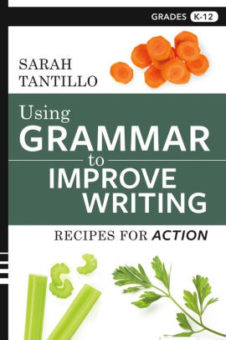Using Grammar to Improve K-12 Writing
Using Grammar to Improve Writing: Recipes for Action
By Sarah Tantillo
(Published by the author, 2018. Learn more)
 Reviewed by Amanda Berry
Reviewed by Amanda Berry
In my perpetual search for programs that teach grammar in order to improve writing, it seems that no grammar text ever fits exactly. I am busy trying to implement this practice in my eighth-grade classroom every day, constantly adapting materials or creating from the ground up.
So when I saw Sarah Tantillo’s Using Grammar to Improve Writing: Recipes for Action, I was ready to bite. Tantillo pitches her book to an audience that is stuck on outmoded ways of teaching grammar.
While her “horse and buggy” analogy is overstated, the goal of integrating grammar and writing instruction is one that many ELA teachers share, especially in the face of shrinking contact hours. She presents her work as a systematic approach to integration following the Common Core Standards.
Tantillo’s ultimate goal is “to enable students to write more efficiently and effectively.” No teacher could argue with that! To do this she uses an approach of “deliberate practice” in which students give focused attention to model sentences and then imitate and apply the grammar forms in their own writing. This inferential approach, in which students analyze how the grammar works, is laid out in Part I, “Guiding Principles of Effective Grammar and Writing Instruction,” particularly in the second chapter.
It is not a totally new approach – she acknowledges the work of Constance Weaver, Doug Lemov, Jeff Anderson, and others, with a passing nod to Henry Noden – but it is at the heart of her work and what makes it most appealing. Her ultimate goal is to provide suggestions for application in the classroom, and this is where the book feels incomplete.
Standard by standard guidance
Part 2 supplies standard by standard guidance for how to teach the material, breaking the grades into logical groupings: K-2, 3-5, 6-8, and 9-12. It is an ambitious undertaking.
She follows the standards meticulously, treating the Writing and Language standards separately, even when she has nothing to add to a less relevant standard. After a standards section, she adds a “Deeper Dive” section in which she looks at how to teach and assess the language standards in conjunction with writing instruction.
As a useful step toward integrating the skills, Tantillo suggests some connections between grammar topics and specific genres, and it would helpful to have even more of this or even additional connections to modes of writing.
Tantillo brings a wealth of teaching experience from the classroom. Her quirky sense of humor comes through in a clear cool teacher voice. Some of her examples of model sentences are more relevant for her teacher readers than for the students they work with. I found one of her more endearing suggestions is for teaching tone with “Cat vs. Dog” (in a section not related at all to grammar). Sometimes she throws in gems that may also leave the reader wondering what the connection is but thankful for the ideas.
In a book offering a systematic approach, the tangents can be confusing. Because of her integrative approach, Tantillo does much more than grammar, and the title may seem misleading. This makes her discussion feel a little stretchy to me. For example, she spends much time discussing writing standards that are not related to grammar.
A limiting structure
The standards structure of the book is limiting because of the way the Common Core separates skills into different strands. Because Tantillo follows the Writing and Language standards separately before diving deeper, she maintains order at the expense of more complex insights about the language.
It also results in distracting repetition as when she deals with trajectories by “recycling” lessons from previous sections. This is to me one of the more serious drawbacks of the book. The danger is that the grammar is treated as more static content to be reviewed rather than as skills that are organic and developing.
Tantillo cannot be faulted for the shortcomings of the standards, and in fact she points some of them out. Phrases such as “teaching the standards” or “reviewing the standards” rather than the elements contained in them may be a common shorthand, but it reveals a mindset that is not entirely compatible with integration and an over-reliance on the standards to provide the systematic framework.
Who might benefit from this book
The book might be useful for teachers using the Common Core who are not comfortable with teaching grammar, who are not sure where to begin, or who need some refreshers. It does not serve as a sole source for grammar, although she does provide links to other resources. She also includes supplemental materials, both in the appendix and online, that could be useful for organizing and tracking the lessons.
The formatting in the book is clunky. Some footnotes are repeated, and footnotes in the charts are numbered separately and then double-noted in order to include them in the list of footnotes. There are big gaps on many pages because the tables or charts do not fit. The text often refers to online resources that include both links and original material.
Tantillo’s systematic approach may be easy to use as a reference, but I found that I had to dig to find some of the more practical suggestions. I like that she focuses on sentences that succeed and I share her inferential approach. But as a program for using grammar to improve writing, her “Recipes for Action” left me a little hungry for more deep connections between grammar and writing.
Amanda Berry teaches middle school English Language Arts at an independent school for girls in New Jersey. Her poetry has appeared in English Journal, Birmingham Poetry Review, Edison Literary Review, and other publications. Her chapbook of poems, Second Sight, was published by Finishing Line Press.

































